The definitions below roughly follow the order of appearance in the story. Most of our medical and surgical terminology derives from Greek or Latin, so anything that is italicized originated from one of those two languages.
Shit magnet: a student or resident who receives an inordinate number of pages on their call night, resulting in little or no sleep.
ER thoracotomy: Thoraco- derives from the Greek word thorax (chest), and -tomy comes from the Greek word tome (incision), so thoracotomy is the surgical term for incising the chest. “Cracking” a chest is jargon for an emergency room thoracotomy. Read my blog post for a thorough discussion of this topic, and to view some graphic (and possibly disturbing) videos of actual ER thoracotomies being performed.
Ventricular fibrillation: complete loss of the rhythmic contraction of the heart. The muscle fibers continue to contract, but in a disorganized and independent fashion, giving the fibrillating heart a “bag of worms” appearance. No longer receiving blood, the heart muscle quickly becomes hypoxic (hypo = under; ox- = oxygen) and turns a blackish-blue color. Without treatment, VF is fatal within minutes.
Ambu bag: a pliable plastic bag the size and shape of a football. By repeatedly squeezing the bag oxygen is pumped into the lungs. During respiratory distress or cardiac arrest, bagging is preferred over mechanical ventilation, in that a higher respiratory rate can be achieved.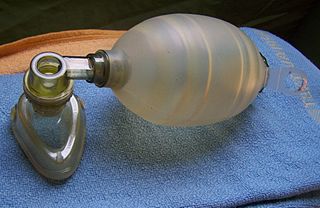
Rib spreader: a heavy retractor that generates significant leverage, thus allowing the ribs to be spread apart far enough to allow access to the chest cavity.
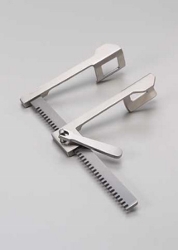
Cross-clamp: vascular clamps come in a variety of shapes and sizes. A long, slender clamp is necessary to reach deep in the chest and cross clamp (totally occlude) the aorta.
Pericardial sac: a dense, fibrous sac that surrounds the heart (peri = around; kardia = heart).
MVA: motor vehicle accident.
Unrestrained: not wearing a seatbelt.
Intern: a first-year resident.
Chief resident: a senior resident who functions as the chief of the service on which he or she is assigned. For a more detailed discussion of the surgery residency training system, go to my blog post on the topic.
Pulse oximeter: a device that monitors the percent oxygen saturation in the blood. This can be done noninvasively by placing a clothespin-like clip on the fingertip, which measures the level of oxygen in the blood flowing through the capillary bed of the fingernail.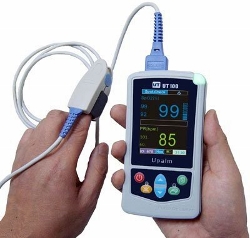
O-2 sat: oxygen (O²) saturation. Mid to high 90’s is good. Mid to low 80’s is cause for concern.
14/16 gauge IV’s: intravenous (intra = within; vena = vein) catheters are sized in terms of gauge. Sixteen is big. Fourteen is really big. If you can get two or three 14 gauge catheters in a patient, you can deliver large volumes of IV fluid very quickly.
Airway: the mouth, pharynx, larynx and trachea all comprise the airway—the path that air follows from the atmosphere to the lungs. Maintaining “control” of the airway is the first priority when treating a severely injured trauma patient.
Endotracheal tube: a plastic tube that is inserted through the mouth (or nose) and advanced into (endo = within) the trachea. It gives the first responder or ER physician control of the airway.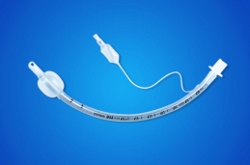
Intubate: the act of placing an endotracheal tube.
Intubation tray: a tray containing the instruments needed to perform an intubation, primarily a laryngoscope and a selection of blades.
Laryngoscope: an L-shaped instrument with a handle and a detachable blade. The blade is placed into the pharynx, and by lifting the base of the tongue, the vocal cords (which reside in the larynx) are visualized. The endotracheal tube is then advanced through the cords into the trachea.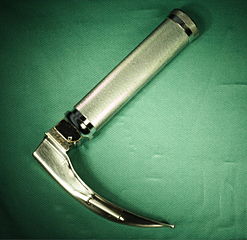
Larynx: the “voice box” or “Adam’s apple.” This is where the vocal cords reside and the trachea begins.
Agonal: agony is defined as intense pain of mind or body, or the struggle that precedes death. Agonal respirations are feeble gasps of air that are insufficient to sustain life. Immediate intubation is paramount.
C-spine: the cervical (neck) spine. In an unresponsive trauma patient, the first responders and evaluating physicians have to assume spinal injury is present until proven otherwise. For this reason, x-rays of the spine are taken before the patient is removed from the backboard.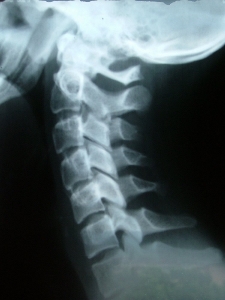
Succinylcholine: (sucks-in-il-kō’-lēn) a short-acting intravenous drug that paralyzes every muscle in the body within seconds, including the breathing muscles, therefore necessitating immediate intubation. It is often used to paralyze combative or unstable patients who need to be intubated emergently.
IV push: a medication is given intravenously using a syringe.
IV drip or infusion: a medication is infused continuously via intravenous access. Morphine, for example, can be administered IV push as a single dose, or as a continuous infusion.
Epinephrine: one of the stress hormones. Secreted by the adrenal glands, it is also known as adrenaline. Epinephrine and its cousin norepinephrine stimulate the heart to beat faster and more forcefully, and quickly raise the blood pressure by constricting the arterial system.
“Bag him”: use an ambu bag to hyperventilate the patient and rapidly increase oxygen saturation. Not to be confused with “tag him and bag him.”
“Trauma is a recurrent disease”: one of the many truths I learned as a surgery resident at LSU. Most of the traumatic injuries we treated were associated with drugs, alcohol, firearms, stabbing implements, blunt objects, motor vehicles, or any combination thereof. Despite suffering serious, and often life-threatening injuries, a significant proportion of these individuals failed to modify their behavior and returned to the ER as “repeat customers.”
NG or nasogastric tube: a long plastic tube inserted through the nose, advanced down the esophagus and into the stomach. When connected to a suction canister, it will empty the stomach. In layman’s terms, this is known as pumping the stomach.
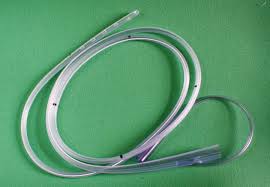
Attending surgeon: a board certified surgeon who supervises the residents and students rotating on his or her service.
Xiphoid to pubis: from sternum to pubic bone. When performing a trauma laparotomy (laparotomy = opening of the abdominal cavity), a large incision enhances the ability of the surgeon to explore the entire abdomen.
Lap sponges: laparotomy sponges. They resemble small towels and possess great absorbency. Ideal for soaking up blood, pus or other abdominal fluids.

Liver resection: resectus is Latin for cut off, or cut out, a portion of a structure or organ. Thus, removal of part of the liver.
Splenectomy: ectomy is the complete removal of an organ. Thus, removal of the spleen.
Colostomy: an ostomy is a surgically formed opening that is frequently temporary, but may be permanent. A colostomy is a connection between the colon and the abdominal wall.
Tracheostomy: an opening between the trachea and the neck. Patients who require prolonged intubation will be converted to a tracheostomy so the endotracheal tube can be removed. This reduces the risk of pneumonia and bleeding, improves oral hygiene, and is more comfortable for an awake patient.
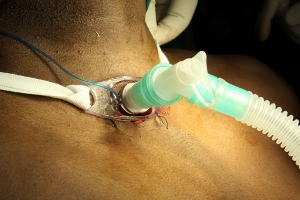
Morning rounds: in order for the surgery residents to get to the OR for the start of the day’s elective cases (generally between 7 and 7:30), morning rounds may commence as early as 5:00 or 6:00 a.m., depending on the complexity and number of patients on the service. Some residents expect the medical students to pre-round on their patients, which means getting to the hospital between 4:00 and 5:00 a.m.
Aorta: the largest artery in the body. It begins at the heart, ends at the pelvis, and every other artery branches from it.
Pulmonary contusions: if you smash your thumb with a hammer, the capillaries become “leaky,” allowing serum, rich in inflammatory cells, to leave the blood stream and start the healing process. When the lungs are contused (bruised), fluid leaks from the capillaries into the air sacs where oxygen exchange takes place. When these sacs fill with fluid, oxygen cannot enter the bloodstream. If the contusions are bilateral (involving both lungs), the patient becomes progressively hypoxic and may reach a point where, despite mechanical ventilation, they cannot be oxygenated and they die.
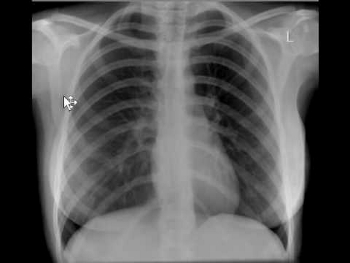
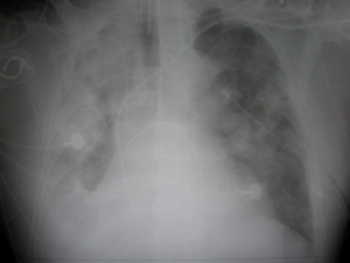
Metastatic cancer: cancer that has spread beyond the site of the primary tumor. When the metastatic lesions become widespread, they compete with the body for nutrients, resulting in malnutrition, weight loss and death.
Jugular venous catheter: a specialized IV catheter that is inserted into the jugular vein and advanced to the right atrium of the heart. In critically ill or injured patients who need long-term IV access, a “central line” is preferable to the smaller catheters placed in peripheral veins. 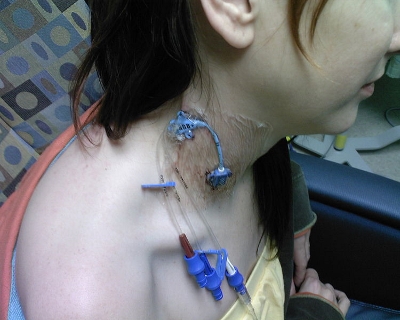
Cardiac myocytes: myo is the Greek root word for muscle, and -cyte is Greek for cell. Cardiac myocytes are the muscle cells of the heart.
Intra-abdominal abscess: an abscess within the abdominal cavity. This is not unusual following a colon injury that has contaminated the abdominal cavity with feces.
Stress hormones: cortisol, epinephrine and norepinephrine are the big three. They prepare the body for “fight or flight,” which is a short-term protective mechanism. Chronic exposure is deleterious.
Morbidity and Mortality conference: morbid is Latin for disease. Mortal is Latin for causing death. The morbidity and mortality conference (held weekly where I trained) is a forum for the discussion of any deaths or complications that occurred on the surgery service during the prior week.
Supra-physiologic: supra- is Latin for above. Supra-physiologic pertains to levels of a naturally occurring substance, compound, hormone, electrolyte, etc. that are higher than expected.
Extracellular space: extra- is a Latin prefix meaning outside of, in addition to, or beyond. The extracellular space is that area in between the cells of the body.
Intracellular space: intra- cellular is the space within a cell.
Gross examination: the examination of an organ as a whole, as opposed to microscopic examination at the cellular level.
Water-hammer pulse: a quick, pounding pulse.
Cyto-architecture: cyto- is the Greek prefix for cell. Cyto-architecture is the cellular structure of an organ or tissue.
Diaphoretic: sweating profusely.
Forceps: medical term for tweezers or pincers.
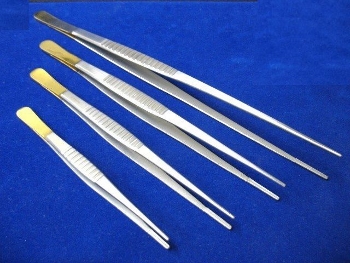
Post mortem: after death.
Bowel: intestine.
Depressed skull fracture: a portion of the fractured skull is displaced inward, thus pushing on or lacerating the brain.
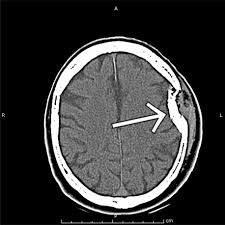
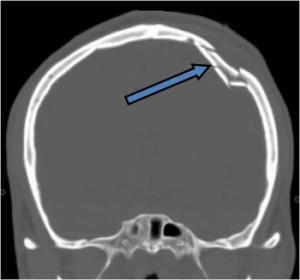
MCAT: medical college acceptance test. Ace it, and as long as you don’t have a third eye in the middle of your forehead, you are in.


